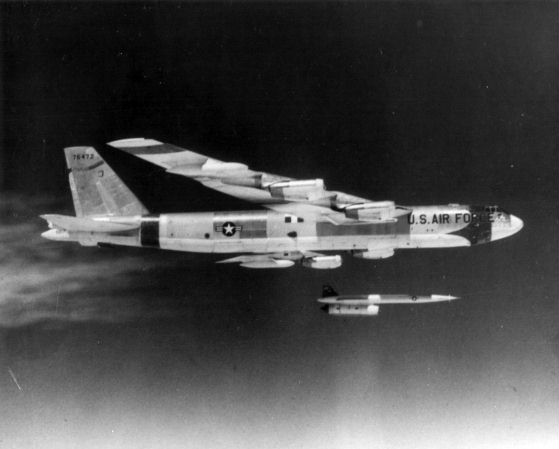B-52 FACT SHEET
By Cliff Lethbridge

B-52
Launch Status: No Longer Used for Cape Canaveral Missile/Rocket Launches
First Cape Canaveral Launch: April 23, 1959
Final Cape Canaveral Launch: February 9, 1993
Total Number of Cape Canaveral Launches: 101
Vehicles Launched: Hound Dog, Skybolt, SRAM, Pegasus
Function: Strategic Heavy Bomber
Contractor: Boeing
Power Plant: Eight Pratt and Whitney J-57 Turbojets
Power Plant Thrust: 10,000 pounds each engine
Wingspan (Model A through H): 185 feet
Length (Model A through F): 156 feet
Length (Model G and H): 157 feet
Height (Model A through F): 48 feet
Height (Model G and H): 40 feet, 8 inches
Speed: 600 m.p.h.
Ceiling: 50,000 feet
Range (Model A through F): 6,000 miles (without aerial refueling)
Range (Model G): 7,500 miles (without aerial refueling)
Range (Model H): 9,000 miles (without aerial refueling)
Bomb Load/Cargo Capacity: 20,000 pounds
Armament: Four .50 caliber machine guns in tail
Crew: 6
Maximum Gross Takeoff Weight (Model A and B): 350,000 pounds
Maximum Gross Takeoff Weight (Model C through F): 400,000 pounds
Maximum Gross Takeoff Weight (Model G and H): 450,000 pounds
Primary Using Command: Strategic Air Command
The first production version of the B-52 “Stratofortress”, named the B-52A, was first flown on August 5, 1954. The B-52 fleet continued to undergo modifications and upgrades through version B-52F. Improvements were primarily in the area of fuel capacity, weapons versatility and reconnaissance capability. Versions B-52A though B-52F were similar in outward appearance and fulfilled a role as traditional heavy bomber.
Follow-up version named the B-52G was modified to support testing and deployment of GAM-77 Hound Dog missiles. The B-52G was slightly longer than previous versions and had a shorter vertical tail. The B-52G also had an improved range over previous versions. An improved version named the B-52H introduced turbofans to vastly improve performance and range.
For a time, all U.S. Air Force B-52G and B-52H bombers were equipped with one Hound Dog pylon under each wing. The Hound Dog actually transformed these bombers from eight-engine to ten-engine aircraft at takeoff.
One Hound Dog missile located under each wing was actually ignited at takeoff, providing extra thrust for the bomber itself. The Hound Dog engines were then shut down, and the missiles were re-fueled directly from the B-52’s own tanks during flight. Once re-fueled, the missiles were ready to be fired again and sent on their way, after the proper guidance and target information could be entered and verified.
B-52G and B-52H aircraft supported a large number of GAM-77 Hound Dog missile test and crew training missions over Cape Canaveral waters. Aircraft were typically flown from Strategic Air Command bases over Atlantic Ocean waters, where the missiles were dropped and fired.
B-52 aircraft were also flown in support of Skybolt Air-Launched Ballistic Missile (ALBM) and Short-Range Attack Missile (SRAM) tests. A modified B-52 aircraft held in the NASA inventory was also used to support a Pegasus rocket launch. Skybolt, SRAM and Pegasus vehicles were also dropped from B-52 aircraft and fired over open Atlantic Ocean waters.
.


